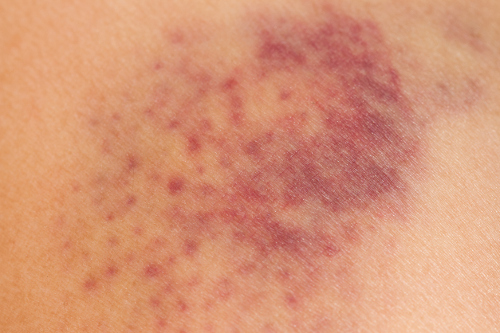 We depend on our body to control the blood flow within our capillaries for the proper functioning of our cells and organs, which includes the body’s ability to form blood clots when necessary such as when we have a cut.
We depend on our body to control the blood flow within our capillaries for the proper functioning of our cells and organs, which includes the body’s ability to form blood clots when necessary such as when we have a cut.
A serious condition referred to as bleeding diathesis can occur if we have an insufficient number of platelets, a damaged blood vessel, or a fault with our clotting ability. It can be a hidden danger that may lead to serious and even fatal consequences.
We will learn more about this condition and possible treatments to stop excessive bleeding.
Bleeding Diathesis Definition
What is bleeding diathesis? To answer that question, we must first understand how the term refers to the health of our body. Diathesis is the body’s tendency to be affected by a group of disorders. Bleeding diathesis is the body’s abnormal inclination to bleed. The varying forms of bleeding diathesis can range from mild to severe.
This disorder’s tendency to hemorrhage has a link to hypocoagulability, a condition having irregular and slow blood clotting. As a result, this can lead to a reduced production of platelets, which in turn results in excessive bleeding.
Cushing’s syndrome (which is thinning of the skin) and the body’s inability to mend wounds naturally are two major factors in this condition. The bleeding diathesis can suddenly occur or can result after a surgical procedure.
Bleeding Diathesis Causes
Bleeding diathesis can be traced to several internal and external factors. As stated, it can occur as a result of a medical condition or as a result of an invasive procedure. We will look at all relating aspects of bleeding diathesis.
1. Blood Platelets
Blood platelets have the ability to clot blood as needed with its thromboplastin substance components. In some medical conditions, the platelet production decreases and excessive bleeding occurs. It occurs in leukemia (blood cancer) patients, as platelets do not form in the bone marrow.
2. Vitamin Deficiencies
Excessive bleeding can result in those with deficiencies of vitamins K and C. Our blood vessels require essential minerals and vitamins to maintain their health. A lack of vitamin C can cause the vessel walls to weaken and hemorrhage.
3. Genetics
Depending on your family history, you may not have the blood-clotting ability needed to prevent the bleeding diathesis condition. It occurs with the lack of coagulation factor of either parent and mostly affects the X chromosome. Hemophilia disorders are closely linked to excessive bleeding, as is the Von Willebrand disease.
4. Capillary Defects
Any defects or damage to the walls of the tiny blood vessels known as the capillaries can cause excessive bleeding.
5. Purpura Conditions
A vascular purpura disease can cause bleeding diathesis. This rare condition changes the blood vessels from the inflammation. Senile purpura disease is the result of our blood vessels weakening from the aging process.
6. Infections
The effects on the blood vessels from infections such as dengue, hemorrhagic fever, septicemia, or meningitis can cause excessive bleeding.
7. Chemical Substances
Common and unique chemicals found in certain medications can cause excessive bleeding. These can include quinine, phenylbutazone, and even Aspirin.
The venom from a snake bite can affect the walls of the capillaries once the substance is in the blood stream and cause bleeding diathesis.
Bleeding Diathesis Symptoms
The symptoms of bleeding diathesis extend beyond the excessive bleeding within the blood vessels and tissues. There are other physical changes to take note of, as well as the amount and type of bleeding.
Purpuras are small red or purple patches indicating a leakage of blood from the vessels under the skin. It can also present as tiny spots on the lower legs and are called petechiae.
Ecchymoses spots are large in size and change from red to purple within two days. They appear with clotting defects, especially with bleeding diathesis.
Anemia can develop with a lack of red blood cells to bind essential oxygen needed by the body cells. By having excessive bleeding, the loss of blood can lead to anemia.
Bruises indicate a below surface blood leakage. They can appear without any trauma or injury to the body.
Prolonged bleeding from a small minor cut or scrape can lead to bleeding diathesis. It can also happen with tooth extractions, even with no indications or diagnosis of gum disease. It can also occur with nose bleeds and menstrual bleeding.
Bleeding Diathesis Treatments
A bleeding diathesis treatment is dependent on the underlying cause of the bleeding. It is vital to stop the blood loss first to prevent further complications and life-threatening conditions.
Of the varying types of bleeding diathesis, one or more of the therapies used can be plasma exchange therapy, platelet transfusions, or anticoagulants. From these treatments, patients may experience anemia, cerebral hemorrhage, or soft tissue bleeding.
Other immediate treatments include prolonged bleeding from the nose with gauze and a packed dressing. Any genetic disorders leading to bleeding diathesis may require a psychological treatment with genetic counseling for management and any family planning.
Bleeding diathesis refers to a tendency to bleed excessively. This condition is a result of mild and severe health conditions and circumstances. It can even be stimulated by a surgical procedure, whether medical or dental.
Since it can be disguised with minor symptoms like bruises or an excessive nose bleed, it is important to stop the bleeding immediately. This disorder itself along with complications can lead to life-threatening conditions.
Sources:
“What Causes Bleeding Diathesis? Its Symptoms And Treatment Options,” Tandurust, September 11, 2012; http://www.tandurust.com/health-answers/bleeding-diathesis-causes-symptoms.html, last accessed June 22, 2017.
“Causes Of Bleeding Diathesis: Symptoms, Diagnosis And Treatment,” Simple Remedies, May 8, 2015; http://www.simple-remedies.com/home-remedies/autoimmune-diseases/bleeding-diathesis-causes.html, last accessed June 22, 2017.
“What Is Bleeding Diathesis?” Wise Geek; http://www.wisegeek.com/what-is-bleeding-diathesis.htm, last accessed June 22, 2017.
